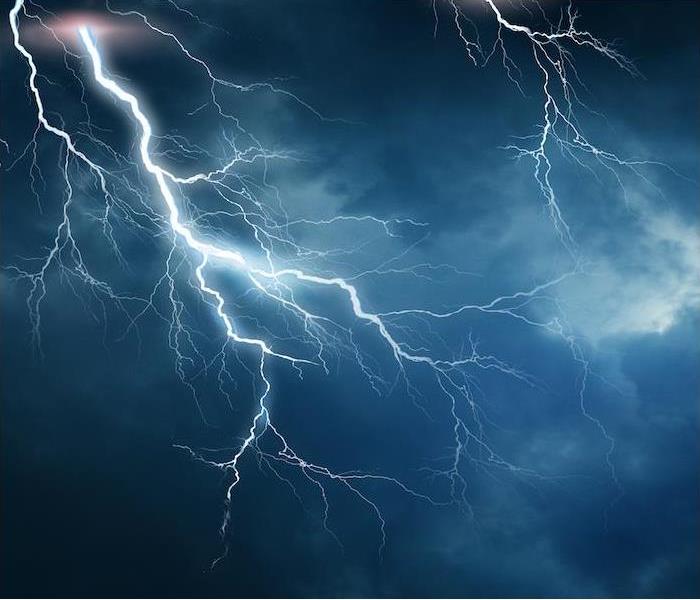Types of Storm Damage | SERVPRO® of Cape Girardeau & Scott Counties
8/18/2022 (Permalink)
 When you suffer storm-related damage to your home or business, make SERVPRO of Cape Girardeau & Scott Counties your first call.
When you suffer storm-related damage to your home or business, make SERVPRO of Cape Girardeau & Scott Counties your first call.
When a storm rolls in, we all begin to worry about the safety of ourselves and the safety of our homes. Most homes are constructed to withstand a good deal of weather, but even the strongest house in the safest spot could still see damage when a crazy storm moves in.
Disasters can arise from winds, freezing rain, snow, floods or hail, and will vary according to the season. All storms that occur throughout the year, large or small, can be a threat to your property.
What your home is exposed to will depend on the kind of storm coming, as well as several other factors when it comes to risks. Geographic location and landscaping are two big factors to consider, as well as the way in which your home is constructed.
While we can see a wide variety of good and bad weather over the year here in the Cape, tornadoes are a serious source of potential disasters. Strong thunderstorms, hail and straight-line winds are also common emergencies we have to contend with. Preparing for the damages that can come when these weather extremes hit is incredibly important.
When you do have damage on your property, it may not be safe to stay in your home. While most storm damage will be obvious immediately, damage may have been done to the structure of your home that you might not be able to see. Let an expert assess your property, and make sure you include alternate locations to shelter in your emergency plans.
No matter what the weather may bring, the more you know about storms and the damages that can result from them, the safer you can keep your home and yourself.
Wind
Wind damage can occur in just about any storm and during any season, but is particularly threatening when gusts pummel buildings at high speeds. Tornadoes and hurricanes always come with extremely intense winds, but even a typical thunderstorm can have gusts of up to 100 mph and pack a powerful punch when it comes to property damage.
Winds at that strength can carry debris long distances and plunk it down on cars or houses. When the winds are picking up, make sure you are inside an interior room, and avoid walls and windows. When debris is thrown around in the wind, it can easily break window panes or even puncture walls.
Make a habit of walking your property on a regular basis in order to pick up loose limbs and large rocks. If you have furniture outside of your home, tie it down somehow so that it can’t be thrown in the wind. And if you have been meaning to take down that dead tree, go ahead and get it out before Mother Nature does.
Water
Water damage is one of the most common ways properties are damaged across the United States. Even when a storm isn’t severe, it can dump a substantial amount of rain and create ponding water or flash floods that will threaten your home.
Keep an eye on your window and door seals to ensure water doesn’t intrude from these two locations during storms. If enough water pools up, it can begin to soak through the very foundation of your home and can cause structural damage.
You can limit the extent of damage that water can do though by being intentional about how you use the space on the exterior of your home. Landscape in a way that creates a slope so water runs down, and consider adding a rain garden to your yard. This is a beautiful way to add both curb appeal and a highly effective absorption source.
Your gutters are another important part of water damage mitigation, and should be kept cleaned year-round in order to work effectively. When gutters are filled with foreign substances, the water can overflow and even puddle up on your roof, which can create a leak that could damage every level of your home interior.
Impact
Another common source of damage is from items that make contact, or impact, with your home or other property. Fallen trees or thrown debris are the most common sources of impact damage, which can be completely catastrophic.
The best way to prevent impact damages is to keep your trees trimmed and debris cleaned up. Don’t let Mother Nature take down trees for you—stay ahead of storms and protect your property.
In 2021, the United States saw over $145 billion in weather-related damages. When you take the time to prepare your home and yourself, you can avoid the need to make costly repairs and mitigate your risks to create a safe and secure home.
If you do end up with damages to your property after a storm, call SERVPRO of Cape Girardeau & Scott Counties. We are locally owned and operated, and with 24⁄7 availability, our experts can get your restoration started and finished faster. Our years of experience and industry-leading equipment are ready to work for you in any disaster the moment you call.
When you suffer storm-related damage to your home or business, it’s important that you know who to call! Contact us today to get your storm damage restoration started faster





 24/7 Emergency Service
24/7 Emergency Service